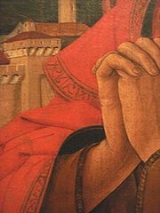
Hem
Encyclopedia

Sewing
Sewing is the craft of fastening or attaching objects using stitches made with a needle and thread. Sewing is one of the oldest of the textile arts, arising in the Paleolithic era...
) is to sew a cut edge in such a way as to prevent unraveling of the fabric.
There are many different styles of hems of varying complexities. The most common hem
folds up a cut edge, folds it up again, and then sews it down. The style of hemming thus completely encloses the cut edge in cloth, so that it cannot unravel. Other hem styles use fewer folds. One of the simplest hems encloses the edge of cloth with a stitch without any folds at all. There are even hems that do not call for sewing, instead using iron-on materials, plastic clips, or other fasteners. These threadless hems are not common, and are often used only on a temporary basis.
The hem may be sewn down with a line of invisible hem-stitch or blind-stitch or sewn down by a sewing machine
Sewing machine
A sewing machine is a textile machine used to stitch fabric, cards and other material together with thread. Sewing machines were invented during the first Industrial Revolution to decrease the amount of manual sewing work performed in clothing companies...
, usually leaving a visible line of sewing. Modern sewing machines designed for home use can make many decorative or functional stitches, so the number of possible hem treatments is large. These home-use machines can also sew a reasonable facsimile of a hem-stitch, though the stitches will usually be larger and more visible.
Clothing factories and professional tailors use a blind hemmer, or hemming machine, which sews an invisible stitch quickly and accurately. A blind hemmer sews a chain stitch, using a bent needle, which can be set precisely enough to actually sew through one and a half thicknesses of the hemmed fabric.
Most haute couture
Haute couture
Haute couture refers to the creation of exclusive custom-fitted clothing. Haute couture is made to order for a specific customer, and it is usually made from high-quality, expensive fabric and sewn with extreme attention to detail and finished by the most experienced and capable seamstresses,...
hems are sewn by hand.
Heavy material with deep hems may be hemmed with what is called a dress-maker's hem — an extra line of loose running stitch is added in the middle of the hem, so that all the weight of the cloth does not hang from one line of stitching.
The term hem is also extended to other cloth treatments that prevent raveling. Hems can be serged (see serger), hand rolled and then sewn down with tiny stitches (still seen as a high-class finish to handkerchiefs), pinked with pinking shears
Pinking shears
Pinking shears are scissors, the blades of which are sawtoothed instead of straight. They leave a zigzag pattern instead of a straight edge.Pinking shears have a utilitarian function for cutting woven cloth. Cloth edges that are unfinished will easily fray, the weave becoming undone and threads...
, piped
Piping (sewing)
In sewing, piping is a type of trim or embellishment consisting of a strip of folded fabric inserted into a seam to define the edges or style lines of a garment or other textile object. Usually the fabric strip is cut on the bias, and often it is folded over a cord...
, covered with binding
Binding (sewing)
In sewing, binding is used as both a noun and a verb to refer to finishing a seam or hem of a garment, usually by rolling or pressing then stitching on an edging or trim ....
(this is known as a Hong Kong finish), or made with many other inventive treatments.
Hem repair


